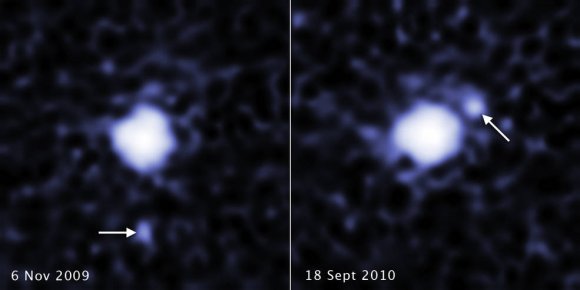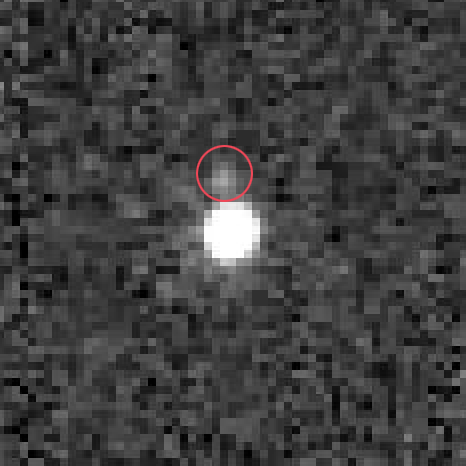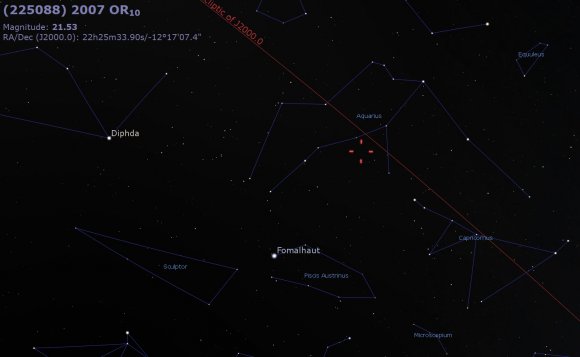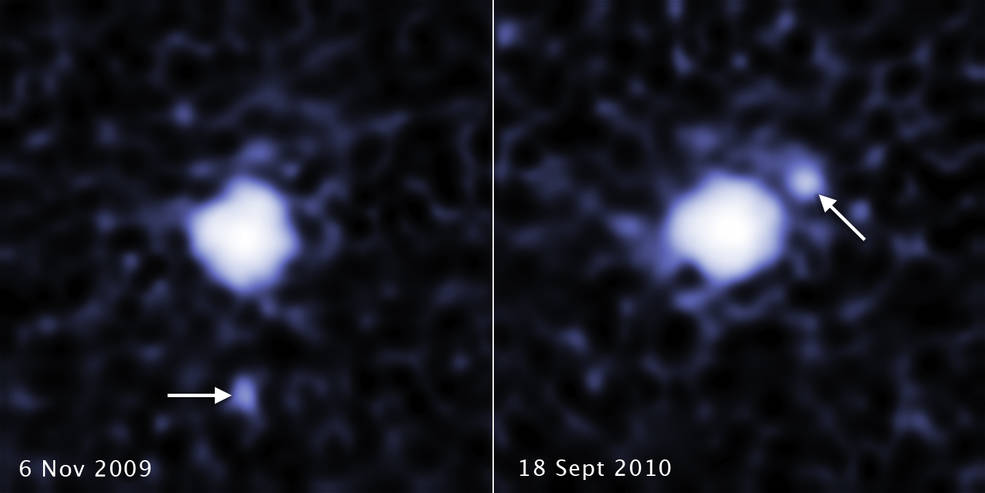
2007 OR10. NASA/Hubble/ESA/STScI
It isn’t every day we get a new moon added to the list of solar system satellites. The combined observational power of three observatories — Kepler, Herschel and Hubble — led an astronomical detective tale to its climatic conclusion: distant Kuiper Belt Object 2007 OR10 has a tiny moon.
The dwarf planet itself is an enigma wrapped in a mystery: with a long orbit taking it out to a distant aphelion 101 astronomical units (AU) from the Sun, back into the environs of Neptune and Pluto for a perihelion 33 AU from the Sun once every 549 years, 2007 OR10 was discovered by Caltech astronomers Megan Schwamb and Mike Brown in 2007. Nicknamed “Snow White” by Mike Brown for its presumed high albedo, 2007 OR10 was 85 AU distant in the constellation Aquarius at the time of discovery and outbound towards aphelion in 2135. 2007 OR10 is about 1,500 kilometers in diameter, the third largest body known beyond Neptune in our solar system next to Pluto and Eris (nee Xena).

Enter the Kepler Space Telescope, which imaged 2007 OR10 crossing the constellation Aquarius as part of its extended K2 exoplanet survey along the ecliptic plane. Though Kepler looks for transiting exoplanets — worlds around other stars that betray their presence by tiny dips in the brightness of their host as they pass along our line of sight — it also picks up lots of other things that flicker, including variable stars and distant Kuiper Belt Objects. But the slow 45 hour rotational period of 2007 OR10 noted by Kepler immediately grabbed astronomers interest: could an unseen moon be lurking nearby, dragging on the KBO like a car brake?
“Typical rotation periods for Kuiper Belt Objects are under 24 hours,” says Csaba Kiss (Konkoly Observatory) in a recent press release. “We looked in the Hubble archive because the slower rotation period could have been caused by the gravitational tug of a moon.”
And sure enough, digging back through archival data from the Hubble Space Telescope taken during a survey of KBOs, astronomers turned up two images of the faint moon from 2009 and 2010. Infrared observations of 2007 OR10 and its moon by the European Space Agency’s Herschel Space Telescope cinched the discovery, and noted an albedo of 19% (similar to wet sand) for 2007 OR10, much darker than expected. The moon is about 200 miles (320 kilometers) in diameter, in a roughly 9,300 mile (15,000 kilometer) orbit.
The discovery was announced at an AAS meeting just last year, and even now, we’re still puzzling out what little we know about these distant worlds. Just what 2007 OR10 and its moon looks like is any guess. New Horizons gave us our first look at Pluto and Charon two short summers ago in 2015, and will give us a fleeting glimpse of 2014 MU69 on New Year’s Day 2019. All of these objects beg for proper names, especially pre-2019 New Horizons flyby.
This also comes on the heels of two new moons for Jupiter, recently announced last month S/2017 J1 and J2.
What would the skies from the tiny moon look like? Well, ancient 2007 OR10 must loom large in its sky, though Sol would only shine as a bright -15th magnitude star, (a little brighter than a Full Moon) its illumination dimmed down to 1/7,000th the brightness enjoyed here on sunny Earth, which would be lost in its glare.

And looking at the strange elliptical orbits of these outer worldlets, we can only surmise that something else must be out there. Will the discovery of Planet 9 be made before the close of the decade?
One thing’s for sure: this isn’t your parent’s tidy solar system with “Excellent Mothers” serving “Nine Pizzas.”


Please use the appropriate term for a hypothesized but undiscovered planet, which is “Planet X,” not “Planet 9,” a very biased term that is based on imposing one view in an ongoing debate as the only view when this is not the case.
I think 2007 OR10 is the largest Solar System object that hasn’t got a proper name yet.